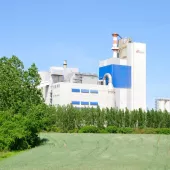Energy Performance Indicators

First published in the March 2017 issue of Quarry Management
Mike Glanfield, founder of Epsilon Energy Professionals, explains how to find the hidden meaning behind the numbers
When it comes to measuring energy performance indicators (KPIs), correct interpretion of the data is perhaps one of the greatest challenges facing professionals in any sector of the economy. If information is conveyed in the form of tables, such as in figure 1, peoples’ eyes tend to glaze over when presented with rows and columns of what, at first glance, appear to be meaningless numbers.
However, when the information in the table is manipulated by the application of analytical tools, the underlying message that the data contains becomes easier to comprehend and the scales can very quickly fall from the eyes.
Monthly consumption of natural gas, for example, may be displayed in the form of a histogram, and if the energy is being used to provide space heating in a building then it is normal for a ‘bathtub’ curve to be presented, showing a greater consumption in the winter months steadily decreasing towards the warmer periods (see fig. 2).
If the annual consumption graph is showing anything other than what might reasonably be expected, it may be time to delve deeper and investigate the reasons why this is so. Another useful diagnostic tool is to display energy consumption in the form of a heat map, where each square is assigned a colour that corresponds to a certain kWh consumption value. The heat map shown in figure 3 illustrates the gas consumption pattern over a 24h cycle on the vertical axis and a time span of 70 days on the horizontal axis.
The results in this example show what might be expected in a controlled environment where the heating comes on at around 4:30am (according to outside and inside air temperatures) and then switches off at about 5:30pm, with no consumption taking place over the weekends or other unoccupied periods.
The colours deepening as the seasons move towards autumn indicates that more gas is being consumed to maintain the required set point temperature. In other words, the chart displays a consumption pattern that one might expect for a heating system that is performing well.
Compare the heat map in figure 3 with the one for a cement factory (fig. 4), where high gas bills have led to an enquiry being instigated. Energy is being consumed almost randomly throughout the 24h cycle and over the unoccupied periods, indicating serious control issues that require further investigation.
A heat map of electricity consumption can also highlight irregularities, such as in the example shown in figure 5, whereby increased electricity consumption as the season moves towards autumn is unexpected because a direct gas-fired warm-air system serves the heating demands of the factory.
Analytical tools such as heat maps and simple charting techniques offer an effective and powerful way of diagnosing problems and also communicating vital information to other actors in an organization.
For more information visit: 50001.epsiloniom.com
- Subscribe to Quarry Management, the monthly journal for the mineral products industry, to read articles before they appear on Agg-Net.com







